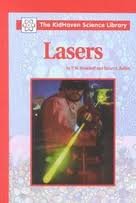-
The KidHaven Science Library - Molds and Fungi
Buffy Silverman
Hardcover (KidHaven Press, July 30, 2004)Molds and other fungi live all over the world. Despite the amazing variety of fungi, all are alike in important ways. This book describes the characteristics of the Fungi kingdom and portrays the life cycles of unusual and important fungi. The role of fungi in the food chain is explored, as is the impact of fungi on people. O
O
-
The KidHaven Science Library - Lasers
Stuart A Kallen
Hardcover (KidHaven Press, Oct. 23, 2001)Lasers are used today in everything from CD players to satellites. Lasers, explores the scientific concepts behind these super tools in easy-to-understand language while exploring the history and development of these miraculous inventions. R
R
-
The KidHaven Science Library - Plate Tectonics
Linda George
Library Binding (KidHaven Press, Nov. 22, 2002)Plate Tectonics is the study of the forces that cause continental drift. When tectonic plates collide or move apart, mountains are formed, volcanoes erupt, and earthquakes occur. These huge plates move one to four inches a year, yet we see and experience effects of that movement every day. P
P
-
The KidHaven Science Library - The Big Bang
Don Nardo
Hardcover (KidHaven Press, Jan. 11, 2005)Scientists believe that more than 13 billion years ago the universe was born in a titantic explosion-the Big Bang. It has been expanding ever since. This volume, aimed at basic readers, explores the evidence for this momentous event, as well as glances far ahead into alternate futures in which the universe either keeps expanding or reverses course and contracts. Q
Q
-
The KidHaven Science Library - Cells
Jeanne DuPrau
Hardcover (KidHaven Press, Oct. 23, 2001)The basic unit of all living things, the cell is a world in itself. This book explores the workings of plant and animal cells -- what they look like, how they're nourished, and how they reproduce. It also describes the role of disease cells in the human body, and how new knowledge about cells provides hope for the treatment of illnesses such as cancer and muscular dystrophy. R
R
-
The KidHaven Science Library - Electricity
Sheila Wyborny
Hardcover (KidHaven Press, March 21, 2003)From an awesome force of nature to providing power for space stations, this book narrates the evolution of electricity from lightning, through superstition, to a multitude of labor-saving, and sometimes life-saving, uses. V
V
-
The how and why wonder book of oceanography: Donald D. Wolf
Robert Scharff
Paperback (Grosset & Dunlap, March 15, 1971)used older book, cracked binding.
-
The KidHaven Science Library - Tide Pools
Marcia S. Gresko
Hardcover (KidHaven Press, Oct. 23, 2001)Tide pools come in all shapes and sizes, and each is different. This book explores life in nature's aquariums -- home to an assortment of amazing animals and peculiar plants. R
R
-
The KidHaven Science Library - Volcanoes
Patricia D. Netzley
Library Binding (KidHaven Press, Dec. 13, 2002)Volcanoes have been erupting since the beginning of the Earth's formation. They have captured humankind's attention with their awesome power and beauty. This anthology covers the science and study of volcanoes, some of the major volcanic disasters, and some of what has been and is being developed to avert potential catastrophe. U
U
-
The KidHaven Science Library - Genetics
Buffy Silverman
Hardcover (KidHaven Press, Oct. 17, 2003)Genetics explains how living things pass on characteristics from one generation to the next. This book introduces young readers to modern genetics, from Gregor Mendel's study of pea plants to the cloning of Dolly the sheep. It also explores how mutations cause genetic diseases, the role genes may play in curing diseases, and the use of DNA fingerprints to identify criminals. M
M
-
The KidHaven Science Library - Light
Bonnie Juettner
Hardcover (KidHaven Press, Oct. 1, 2003)Most of what scientists know about light they have figured out by observing the properties of light. Those properties, along with the fascinating effects and modern uses of light are discussed in this book. Full-color photographs and diagrams help readers understand this topic. Q
Q
